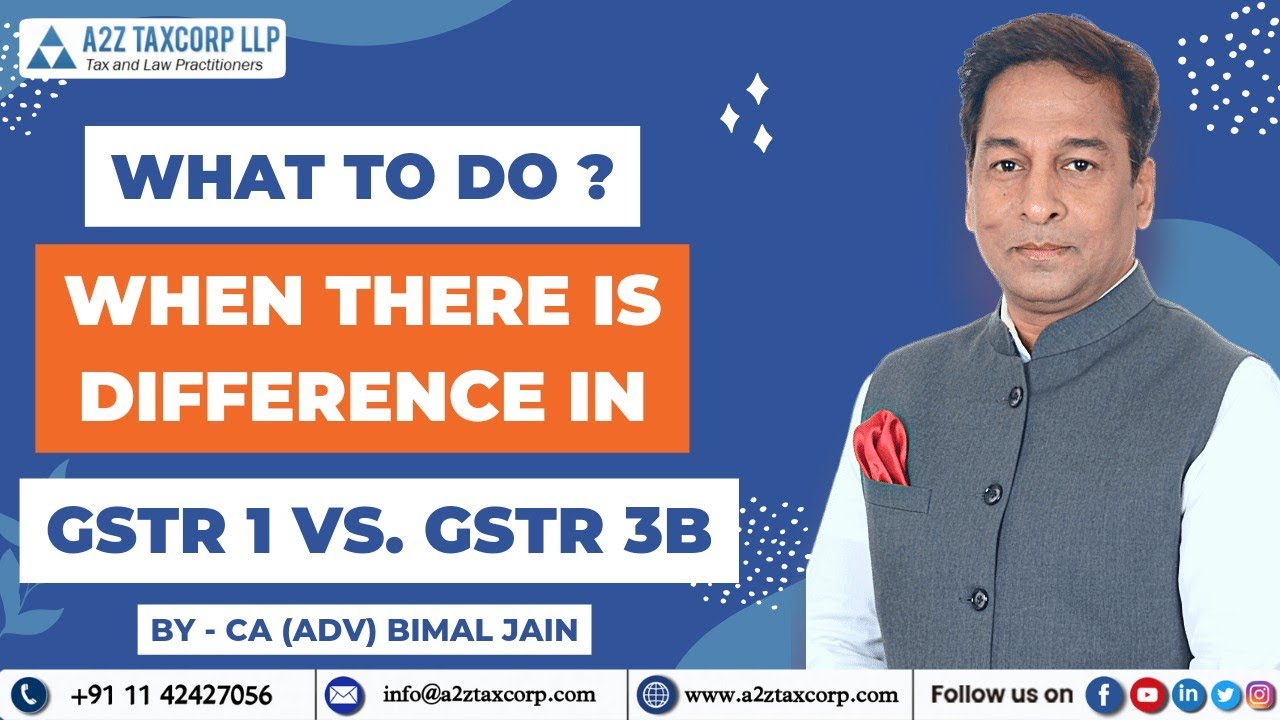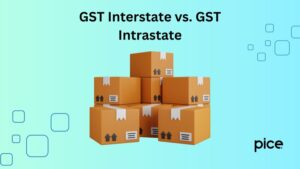GSTR-3B vs GSTR 1 Mismatch
- 3 Sep 24
- 9 mins

GSTR-3B vs GSTR 1 Mismatch
Key Takeaways
- Rule 88C under GST addresses discrepancies between GSTR-1 and GSTR-3B filings.
- Taxpayers must reconcile GSTR-1 and GSTR-3B to avoid penalties and return blockages.
- Non-compliance with Rule 88C can lead to recovery proceedings and tax liability demands.
- Common causes of mismatches include incorrect reporting and amendments after GSTR-1 filing.
- Timely reconciliation of GST returns ensures accurate tax revenue allocation and avoids interest charges.
Since the introduction of the Goods and Services Tax (GST), the government has noticed several discrepancies in tax liabilities across different return filings, notably in GSTR-3B and GSTR-1. With the aim of addressing the GSTR-3B and GSTR-1 mismatch solution, the government introduced Rule 88C into the Central Goods and Services Tax Rules, 2017. In this blog, we will walk you through Rule 88C, its implications for taxpayers and why reconciling GSTR-1 and GSTR-3B is crucial.
What Is Rule 88C Under GST?
The Central Board of Indirect Taxes and Customs (CBIC) introduced Rule 88C in the CGST Rules to automate notifications sent to taxpayers about discrepancies between GSTR-1 or the Invoice Furnishing Facility (IFF) and GSTR-3B filings. With the introduction of Rule 88C under GST, the government now has the authority to demand unpaid liabilities, block return filings and initiate recovery proceedings.
This rule was introduced following suggestions from the 48th GST Council meeting on December 17, 2022, to address the differential liability of taxpayers. These discrepancies can stem from missed tax payments or genuine errors. The registered person is required to provide explanations, and the tax authorities use discretion to differentiate between these cases.
Applicability of Rule 88C
This provision applies when the tax liability reported in GSTR-1/IFF exceeds the tax paid in GSTR-3B by a certain threshold amount or percentage as determined by the council. Any such discrepancies will be addressed under Rule 88C.
Actions on Reconciliation Required by Taxpayers
Taxpayers have 2 options to address FORM GST DRC-01B when there is a discrepancy in their tax liability:
- Taxpayers can choose to pay the full or partial differential tax liability specified in Part A of FORM GST DRC-01B, including any applicable interest under Section 50, using FORM GST DRC-03. They must then furnish the payment details in Part B of FORM GST DRC-01B electronically on the common portal.
- Alternatively, taxpayers can submit a reply electronically on the common portal. In this reply, they must incorporate the reasons for any part of the differential tax liability that remains unpaid, if any, in Part B of FORM GST DRC-01B.
Consequences of Non-Compliance
If the amount specified in DRC-01B remains unpaid, no reply is furnished or the reply provided is deemed unacceptable by the concerned officer, recovery of tax proceedings will be initiated under Section 79 of the CGST Act, 2017.
Section 79 states that, notwithstanding anything contained in the Code of Criminal Procedure, 1973, a proper officer may file an application to the appropriate Magistrate. The Magistrate shall then proceed to recover the specified amount from the person as if it were a fine imposed by the Magistrate.
Causes of Discrepancies Between GSTR 1 & GSTR 3B
Generally, the cases of Form GSTR 1-GSTR 3B mismatches arise due to the following reasons:
- When supplies are reported incorrectly in GSTR-3B but correctly in GSTR-1 invoice-wise, such as zero-rated sales reported in Table 6A of GSTR-1 but mistakenly under Table 3.1(a) in GSTR-3B.
- Issuing an invoice in one month and later issuing a debit or credit note.
- Interstate supplies to unregistered persons, which are declared in GSTR-1 but omitted in GSTR-3B.
- Tax payments made under one head with the value of supplies recorded in different ones, such as CGST & SGST instead of IGST or vice-versa.
- Amendment in supplies made following the filing of GSTR-1 or any other change in tax liability between the filing periods of GSTR-1 and GSTR-3B.
- Invoice reported in GSTR-1 and GSTR-3B at different times.
- Any other typographical error made while reporting.
Significance of Reconciling GSTR-1 and GSTR-3B
Reconciling GSTR-3B and GSTR-1 is crucial for the following reasons:
- As per Rule 88C, taxpayers will be sent an automated intimation via Form DRC-01B, specifying the GSTR-1/IFF vs GSTR-3B mismatches. It is crucial to address this intimation to avoid further blocking of GSTR-1/IFF filing for the subsequent tax period.
- By addressing the annual reconciliation issues, one can ensure that no invoice is omitted or recorded only once in the forms.
- It enables taxpayers to reach a certain amount of output tax payable when it comes to sales made during a specific time period.
- Since January 2021, taxpayers have been required to ensure that the supplies declared in Form GSTR-1 match with the summary total of supplies as of GSTR-3B to avoid suspension of GSTIN.
- Timely GSTR-1 and GSTR-3B reconciliation is crucial to avoid a late declaration of GST liability, which can attract interest.
- Reconciling GSTR-1 and GSTR-3B ensures the correct allocation of tax revenue to states.
- It also helps identify and correct any errors in the integrated tax details entered in GSTR-3B.
- Recipients need GSTR-1 to claim input tax credit when filing their returns. Timely and accurate declarations in both GSTR-1 and GSTR-3B prevent future hassles for recipients and ensure that only genuine input tax credits are claimed.
Vouchers with Conflicting Transaction Details
If a voucher has multiple issues, addressing each one moves it sequentially through the exception categories until all issues are resolved and the entries are included in the GSTR-3B return. In the case of vouchers with conflicting transaction details, the count of transactions where both interstate and intrastate nature of transactions are selected in a single one gets displayed.
Vouchers with Invalid State or Place of Supply
This section lists transactions where the state or place of supply selected is no longer valid. For instance, Daman & Diu was merged with Dadra & Nagar Haveli on July 1, 2020, to form the new Union Territory of Dadra & Nagar Haveli and Daman & Diu. Any transaction dated July 1, 2020, or later that lists Daman & Diu as the state or place of supply is considered invalid, as the Union Territory no longer exists under that name.
Mismatches in Transaction Nature, Place of Supply, and Party's Country
This section displays the count of transactions with mismatch in GST return, between the nature of the transaction, the place of supply and the party’s country.
Discrepancies Due to Modified Tax Amounts in Vouchers
This section displays the count of transactions where a difference is found between the calculated tax amount and the entered tax amount.
Vouchers with Incomplete or Incorrect Adjustment Details
This section shows the count of transactions with incomplete or incorrect GST adjustment details.
Vouchers Involving Reverse Charge and Non-Reverse Charge Supplies
This section displays the count of transactions involving stock items that should attract regular tax rates but are instead taxed under reverse charge.
Vouchers with Incorrect or Mismatched Central and State/UT Tax Values
It displays the count of vouchers where there is a difference between the values of Central Tax and State/UT Tax.
The Bottom Line
Understanding the importance of reconciling GST return forms is crucial for registered taxpayers to address any discrepancies between GSTR-3B and GSTR-1 filings. Neglecting to resolve or choose GSTR-3B and GSTR-1 mismatch solution can lead to demand notices from tax authorities or other issues that disrupt accurate annual return filings.




















